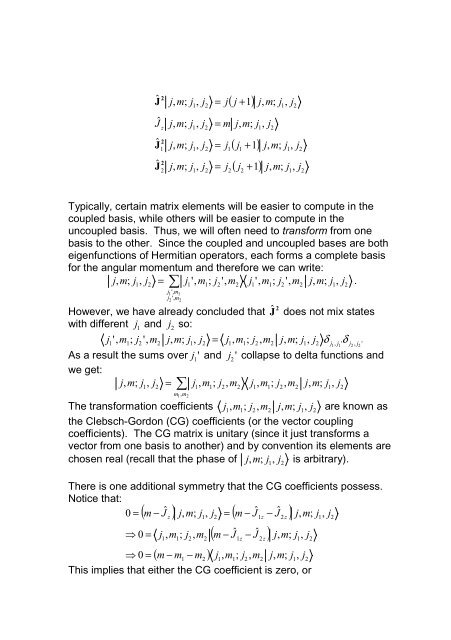VIII. Addition of Angular Momenta
VIII. Addition of Angular Momenta
VIII. Addition of Angular Momenta
You also want an ePaper? Increase the reach of your titles
YUMPU automatically turns print PDFs into web optimized ePapers that Google loves.
J ˆ 2 j,m; j<br />
1, j<br />
2<br />
= j( j + 1) j,m; j<br />
1, j2<br />
Ĵ j,m; j , j = m j,m; j , j<br />
z 1 2 1 2<br />
2<br />
J ˆ<br />
1<br />
j,m; j 1<br />
, j 2<br />
= j 1<br />
( j 1<br />
+ 1) j,m; j 1<br />
, j 2<br />
2<br />
J ˆ<br />
2<br />
j,m; j 1<br />
, j 2<br />
= j 2<br />
( j 2<br />
+ 1) j,m; j 1<br />
, j 2<br />
Typically, certain matrix elements will be easier to compute in the<br />
coupled basis, while others will be easier to compute in the<br />
uncoupled basis. Thus, we will <strong>of</strong>ten need to transform from one<br />
basis to the other. Since the coupled and uncoupled bases are both<br />
eigenfunctions <strong>of</strong> Hermitian operators, each forms a complete basis<br />
for the angular momentum and therefore we can write:<br />
j,m; j , j = j ',<br />
m ; j ',<br />
m j ',<br />
m ; j ',<br />
m j,m; j , j .<br />
1 2 1 1 2 2 1 1 2 2 1 2<br />
j 1 ',<br />
m 1<br />
j 2 ',<br />
m 2<br />
However, we have already concluded that J ˆ 2 does not mix states<br />
with different j<br />
1<br />
and j<br />
2<br />
so:<br />
j<br />
1' , m<br />
1; j<br />
2<br />
',<br />
m<br />
2<br />
j,m; j<br />
1, j<br />
2<br />
= j<br />
1,m 1<br />
; j 2<br />
,m<br />
2<br />
j,m; j<br />
1, j<br />
2<br />
δ j , j<br />
δ<br />
1 1 ' j2 , j 2 '<br />
As a result the sums over j<br />
1' and j<br />
2' collapse to delta functions and<br />
we get:<br />
j,m; j , j = j ,m ; j 2<br />
,m 2<br />
j ,m ; j 2<br />
,m 2<br />
j,m; j , j<br />
1 2 1 1 1 1 1 2<br />
m 1 ,m 2<br />
The transformation coefficients j<br />
1,m 1<br />
; j 2<br />
,m<br />
2<br />
j,m; j<br />
1, j<br />
2<br />
are known as<br />
the Clebsch-Gordon (CG) coefficients (or the vector coupling<br />
coefficients). The CG matrix is unitary (since it just transforms a<br />
vector from one basis to another) and by convention its elements are<br />
chosen real (recall that the phase <strong>of</strong> j,m; j 1<br />
, j<br />
2<br />
is arbitrary).<br />
There is one additional symmetry that the CG coefficients possess.<br />
Notice that:<br />
ˆ ˆ ˆ<br />
0 = (m − J ) j,m; j , j = (m − J 1z<br />
− J 2 z<br />
) j,m; j , j<br />
z 1 2 1 2<br />
0 = j ,m ; j ,m 2<br />
(m − Jˆ<br />
1z<br />
− J ˆ<br />
2 z<br />
) j,m; j , j<br />
1 1 2 1 2<br />
0 = (m − m<br />
1<br />
− m 2<br />
) j<br />
1<br />
,m 1<br />
; j 2<br />
,m 2<br />
j,m; j<br />
1, j2<br />
This implies that either the CG coefficient is zero, or
















